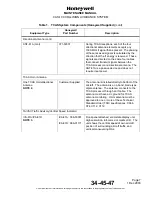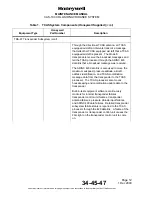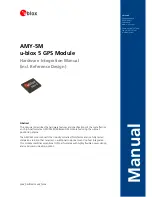
Page 2
1 Dec 2003
34-45-4
7
MAINTENANCE MANUAL
CAS-100 COLLISION AVOIDANCE SYSTEM
Use or disclosure of information on this page is subject to the restrictions in the proprietary notice of this document.
Repetitious TCAS interrogations in the Mode S and the Mode C formats monitor the aircraft
positions. The transponders reply after a set interval when interrogated. The measurement
of time between interrogation transmission and reply reception lets TCAS find the range of the
intruder. If the intruder transponder uses an altimeter input, TCAS receives the intruder
altitude reports in the replies and can find the altitude of the intruder. Transmission and
reception procedures for the TCAS directional antennas let TCAS find the bearing of intruder.
(If an omnidirectional antenna is used as the TCAS bottom antenna, and the intruder is
monitored on the bottom antenna, the intruder bearing cannot be determined. As a result, the
traffic display unit will not display the intruder aircraft position.).
TCAS classifies intruders as nonthreat, proximity, traffic advisory (TA), or resolution advisory
(RA) threat category aircraft. This classification is based on closing rates and relative position
calculated from the reply data. TCAS gives one or more of the following visual and aural aids
to the pilot:
•
If a directional antenna is tracking the intruder, TCAS displays an intruder aircraft
symbol on the traffic advisory display. The symbol position on the display shows
relative range and bearing of the intruder. The symbol shape and color identifies if the
aircraft is categorized as a nonthreat, proximity, traffic advisory or resolution advisory
threat. If the intruder is reporting altitude, intruder relative altitude is shown on the
display.
NOTE:
TCAS only categorizes and displays an intruder aircraft as an RA threat if the
intruder is reporting altitude. Nonaltitude reporting aircraft are referred to as
NARs.
•
If the intruder is tracked on a bottom TCAS omni antenna and is categorized as a TA
or RA, TCAS gives a TA NO BEARING or RA NO BEARING annunciation on the traffic
advisory display.
•
If the intruder is categorized as a TA, TCAS gives an aural traffic advisory alert on the
cockpit audio system.
•
If the intruder is categorized as a RA, TCAS gives an aural resolution advisory alert on
the cockpit audio system. This RA category causes a visual vertical maneuvering
resolution advisory on the vertical speed indicators (TA/VSIs or RA/VSIs).
A TCAS-equipped aircraft includes a Mode S air traffic control transponder and a
transponder/TCAS control unit. The Mode S transponder does the functions required by
TCAS and the non-TCAS functions of existing ATCRBS (Modes A and A/C) transponders.
During a condition where two TCAS equipped aircraft are threats to each other, the TCAS and
Mode S transponder in each aircraft, establish an air-to-air resolution advisory coordination
data link. This link is established to prevent the generation of a similar vertical maneuvering
resolution advisories in the two aircraft.
















































